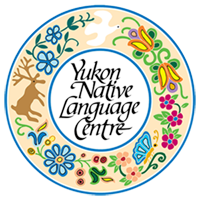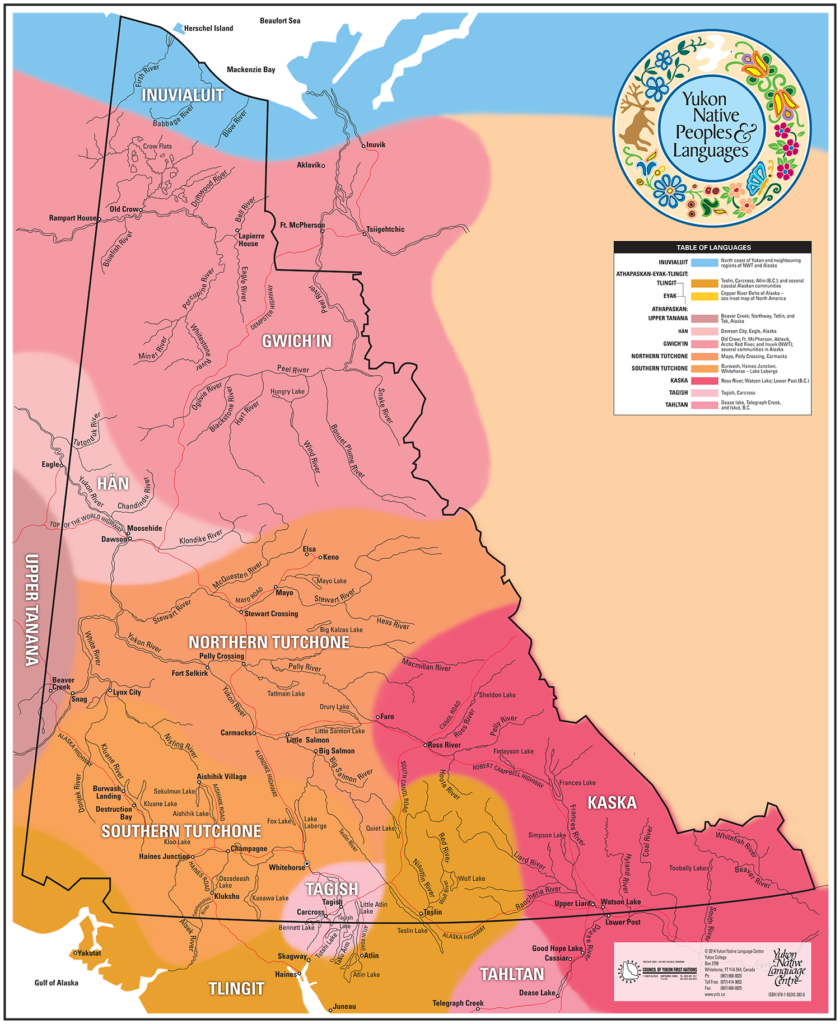Select a language to view our Language Learning Resources:
About Native Languages in the Yukon

The Yukon Territory is in the northwest corner of Canada and borders on Alaska. There are eight aboriginal languages used here. Seven are from the Athapaskan family which spreads from central Alaska through northwestern Canada to Hudson Bay. These seven are Gwich’in, Hän, Kaska, Northern Tutchone, Southern Tutchone, Tagish, and Upper Tanana. There are also pockets of Athapaskan in the lower 48 states including Navajo and Apache. Tlingit is found mostly along the southwest Alaskan coast. Inland Tlingit is spoken in parts of British Columbia and southern Yukon. Tlingit is very distantly related to the Athapaskan family. (For more information on Athapaskan and other languages please see the sites listed by the Society for the Study of the Indigenous Languages of the Americas. You may also be interested in the site of the Alaska Native Language Center since ANLC works on many joint projects with YNLC on Athapaskan languages and Tlingit.)
The map at left shows the areas traditionally occupied by speakers of Yukon Native Languages. Closely related languages are depicted with similar colours. Athapaskan languages are shown in several shades of red. They are distantly related to Tlingit in gold, but not to Inuit shown here in blue. The printed map is available from the centre in two sizes.
There are no strict boundaries between neighbouring languages. Yukon Native people traditionally moved about during the year to hunt, fish, trap, and to visit and trade with other groups. Lines between languages are approximate only, and there are many “joint-use” regions throughout the Yukon occupied by speakers from more than one group.
Some of the traditional villages (shown on the printed version of the map) are now abandoned or used only seasonally. In the newer towns and communities there are speakers of more than one Native language or of more than one dialect of the same language.
Along the Yukon’s arctic coast there is a region traditionally used by Inuit. While there are Inuit place names and archeological sites in the area, there are no permanent settlements. There was once a sizable Inuit settlement on Herschel Island as a consequence of the short-lived whaling era, 1889 to 1908.
Yukon Native people are working actively to teach, document, and enhance their languages. The Yukon Native Language Centre was established by the Council for Yukon Indians in 1977, and over the years it has developed writing systems for the languages and trained people to read, write, and teach Native languages. The Centre also sponsors adult literacy classes and works cooperatively with schools and First Nations in developing language teaching curricula. It publishes dictionaries and compiles collections of stories and placenames. At Yukon College in Whitehorse, the Centre offers Certificate and Diploma programs for Native Language Instructors, both developed in response to the growing need for teachers and instructional programs and materials.
Other groups such as Northern Native Broadcasting Yukon and the Yukon Government’s Aboriginal Language Services Branch are also raising the profile of Yukon Native Languages, through radio and television programming and the provision of interpreter services in the communities.
Further Reading
| McClellan, Catharine | ||
| 1975 | My Old People Say. An Ethnographic Survey of Southern Yukon Territory. 2 parts. [=National Museum of Man Publications in Ethnology, Nos. 6(1) and 6(2).] National Museums of Canada, Ottawa. | |
| 1987 | A History of the Yukon Indians. Part of the Land, Part of the Water. With Lucie Birckel, Robert Bringhurst, James A. Fall, Carol McCarthy and Janice R. Sheppard. Douglas & McIntyre, Vancouver. | |
| Sturtevant, William, General Editor | ||
| 1981 | Handbook of North American Indians. Volume 6. Subarctic. June Helm, Volume Editor. Smithsonian Institution, Washington. | |
| 1990 | Handbook of North American Indians. Volume 7. Northwest Coast. Wayne Suttles, Volume Editor. Smithsonian Institution, Washington. |

